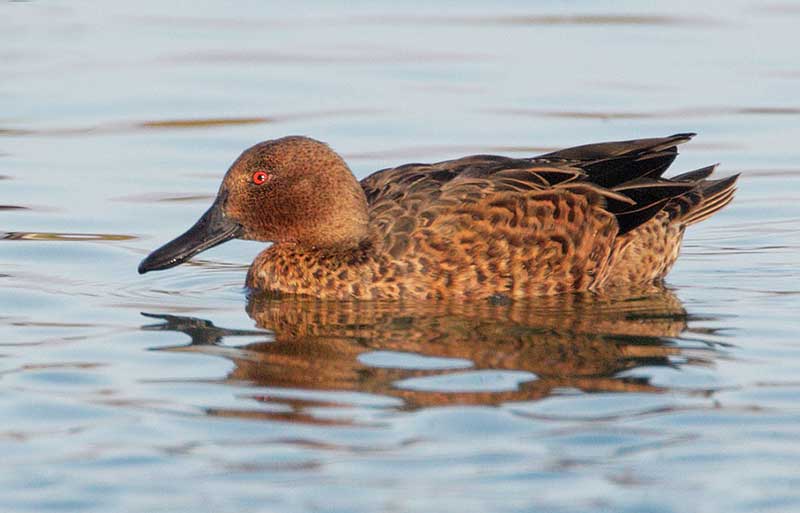The Cinnamon Teal is a small dabbling duck with reddish eyes, and a fairly large, dark bill. It lives in marshes in southwestern Canada, most of the western USA, Mexico, and in parts of the Andes, Chile, and Argentina.
In summer months, this beautiful duck is a typical bird of wetlands in arid and high-elevation areas of Western North America. During the winter, it frequents coastal and low-elevation wetlands in the American Southwest and Mexico.
On this page
Breeding Male
The male Cinnamon Teal has rich, chestnut-colored plumage, a bright red eye, some buff stripes on the back, and an eye-catching pale blue patch in the shoulder of the wing bordered by a bit of white and a patch of dark green. It is slightly larger than the female.
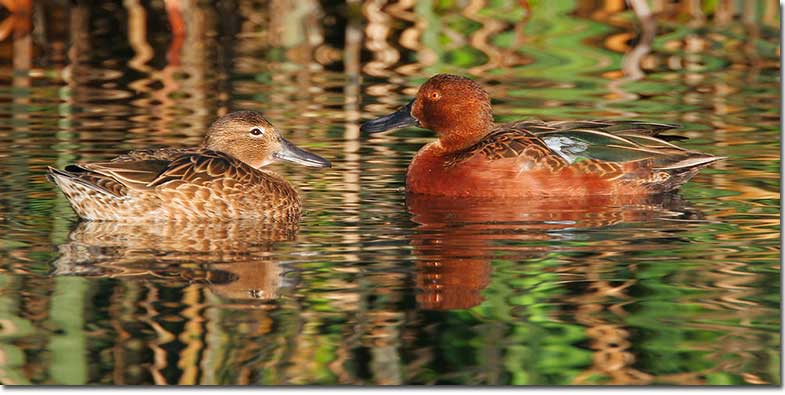
Cinnamon Teak – male and female
Female
The female Cinnamon Teal is slightly smaller than the male and is mottled pale brown with buff. She has a dark red eye on a plain face, and a dull blue patch on the shoulder of the wing.
Juvenile
The juvenile Cinnamon Teal looks like the adult female but is paler brown. They hatch after three weeks and depend on their mother for nearly 50 days more.
Habitat
The Cinnamon Teal prefers a variety of shallow marsh habitats with emergent vegetation in arid and high elevation areas. They build their nests on the ground, in grassy areas next to wetlands.
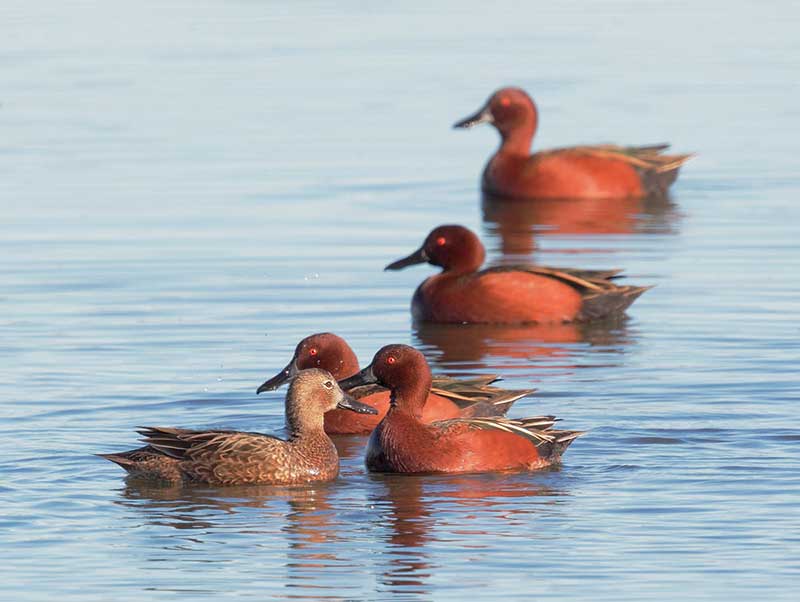
male and female cinnamon teal
Diet
The Cinnamon Teal feeds on seeds and vegetation of various marsh plants including Bullrush, Smartweed, Millet, and Pondweed. It also eats snails and other small mollusks, and small insects such as midges, mosquitoes, flies, beetles, and their larvae.
This handsome duck also eats zooplankton and mostly forages by using its bill to pick and filter plant and insect food from the surface of the water. It also dips below the surface to pick food items from vegetation on the bottom of ponds, ditches, and other wetlands.
This species usually forages in flocks with others of its own species, and other duck species, including the related Northern Shoveler and Blue-winged Teal.
It is most active during the first four hours of the morning but continues to dabble for food throughout the day. The Cinnamon Teal finds food in a wide variety of shallow wetlands and seasonally flooded sites with emergent vegetation, and, during the winter months, also uses brackish water, estuaries, and mangrove forests.
Behavior
On breeding grounds, male Cinnamon Teals squabble over territory but flock together at other times of the year.
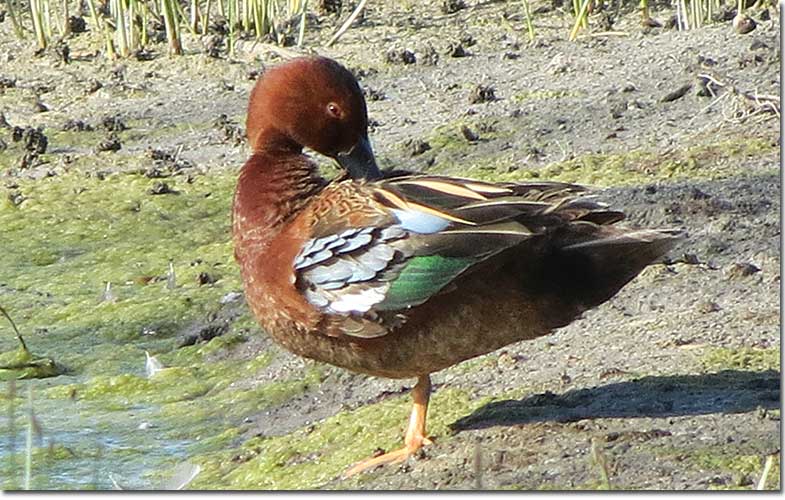
Cinnamon Teal male
They tend to be dominated or “pushed around” by other ducks and American Coots, and are an important food source for Coyotes, Foxes, Raccoons, and various raptors. Perhaps because of hunting in many parts of its range, this duck also tends to be shy around people.
Range (and seasonal changes)
Cinnamon Teals live in a variety of shallow wetlands in southwestern Canada, much of the western USA, in the Mexican highlands, and in parts of the Andes and Argentina. Birds from Canada and the western USA migrate to California, the southwestern USA, and Mexico.
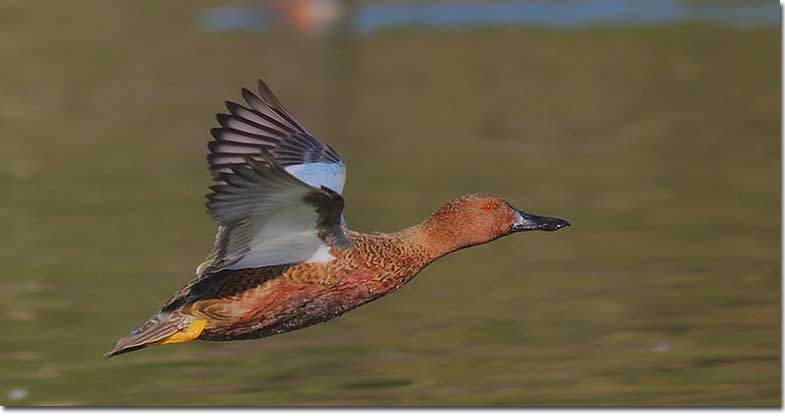
Wing shape
The wings of the Cinnamon Teal are long and pointed, and suited for a quick, vertical take-off from the water, fast direct flight, and migrating for hundreds of miles. The wingspan for this species is around 22 inches.
Fun Facts
- The spiritual meaning of the Cinnamon Teal is one of peace, tranquility, and hope. Some cultures consider this and other teal species to be messengers of a higher power.
- The female Cinnamon Teal accesses her well-hidden nest through tunnels made beneath thick, dead vegetation.
- Cinnamon Teals occasionally hybridize with the related Blue-winged Teal.
- When a female Cinnamon Teal with ducklings feels threatened, she tries to lead the predator away from young by pretending to have a broken wing.
- Coots and some other ducks lay their eggs in Cinnamon Teal nests with the hope that the female teal will incubate and hatch the eggs. In turn, Cinnamon Teals can do the same thing to other ducks.
Call
The Cinnamon Teal is usually quiet but can make brief rattling calls and clucks. The female occasionally gives a quiet series of quacking calls.
Similar Species
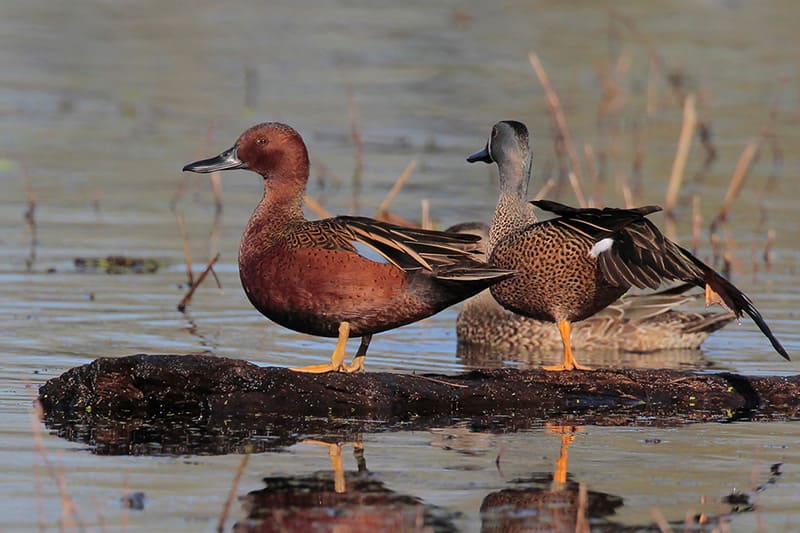
Cinnamon and Blue-winged Teal
When you take a closer look, Blue-winged Teals and Cinnamon Teals do actually look a bit similar. Cinnamon Teals have mainly reddish-orange plumage, but similarly to Blue-winged Teals, they have a good amount of blue and green feathers on their wings.
Blue-winged Teals have dark heads and a white stripe running across their faces.
The two species are roughly the same size, and females look similar.
As we said before, these two species can hybridize, so seeing a mix of too isn’t too rare either.
Frequently Asked Questions
Is a Cinnamon Teal rare?
The Cinnamon Teal is not as abundant as other duck species but is still not considered rare within its usual range.
How many Cinnamon Teals are there in the world?
There are an estimated 260,000 to 300,000 Cinnamon Teals in North America, and at least 80,000 more in South America for an estimated total of 380,000.
Where do you find Cinnamon Teal?
Cinnamon Teal can be seen in shallow marsh habitats with emergent vegetation and shallow coastal wetlands in many parts of western North America, Mexico, in the Andes, and in Argentina.
Does the Cinnamon Teal migrate?
Cinnamon Teals that breed in Canada and much of the western USA migrate to California, the southwestern United States, and Mexico for the winter.

